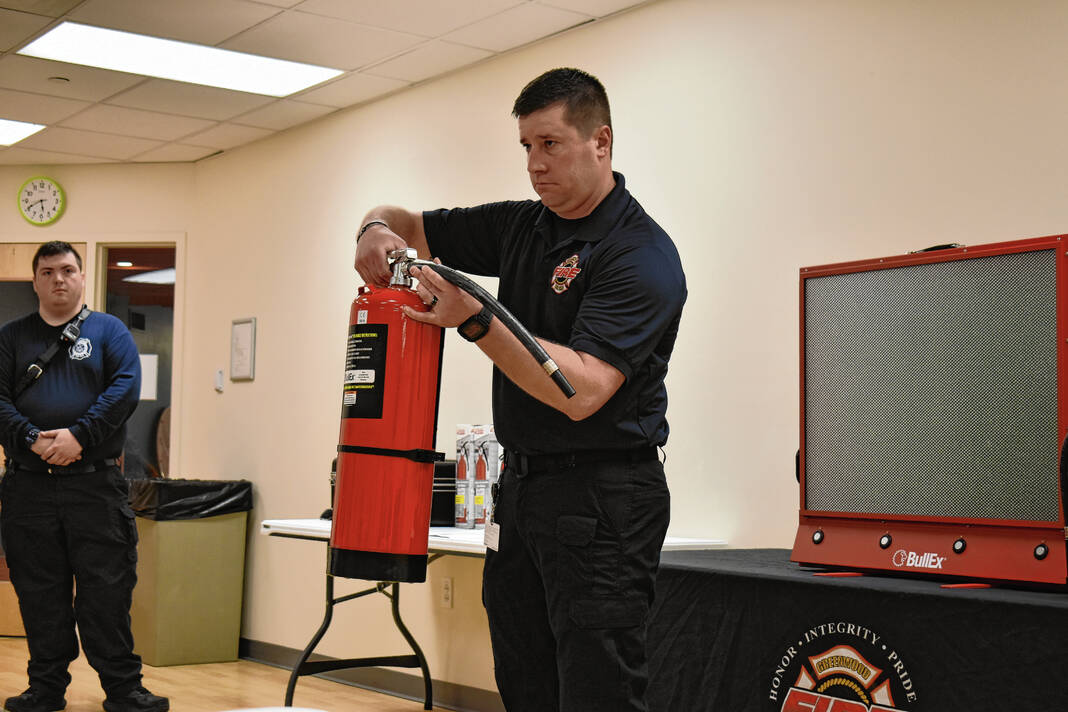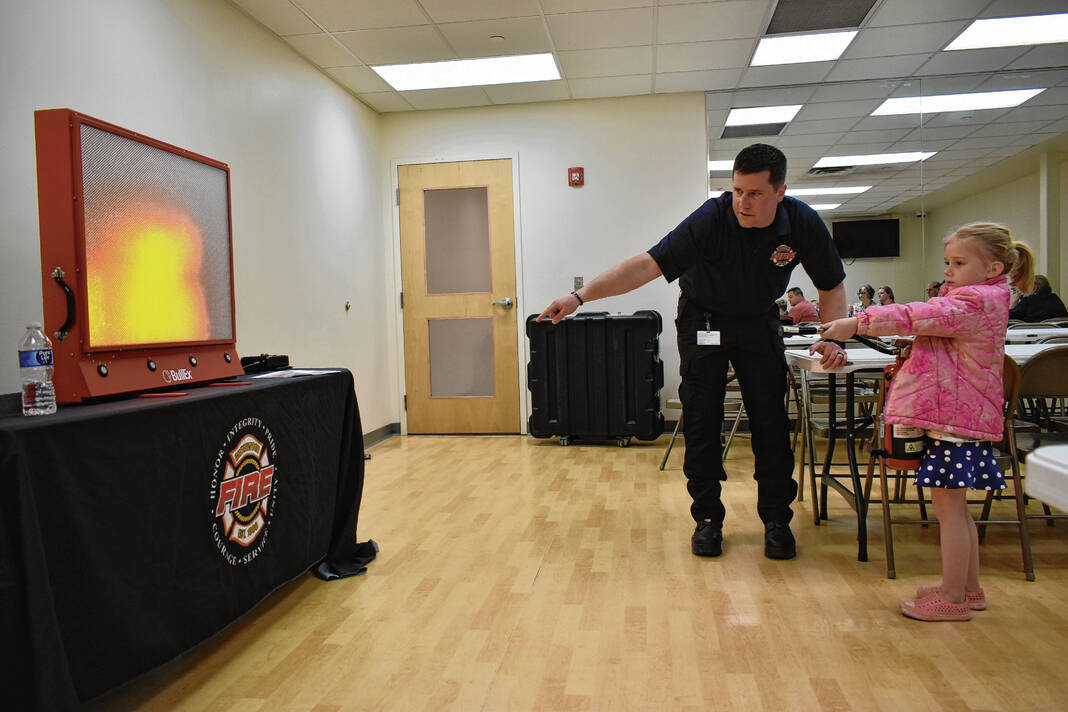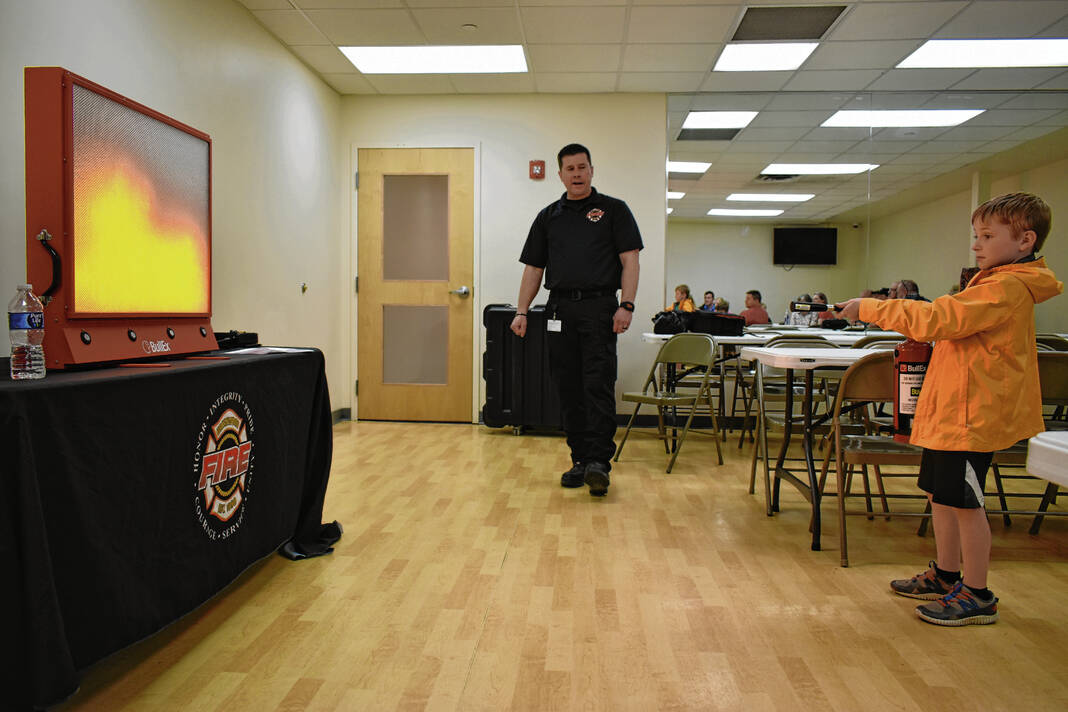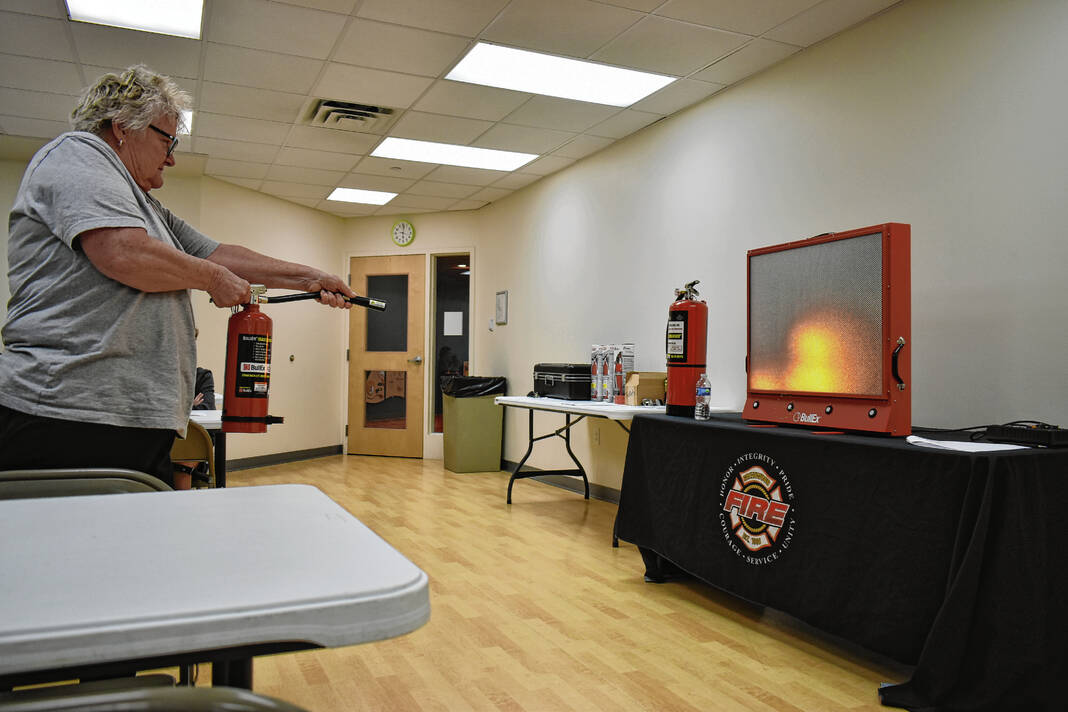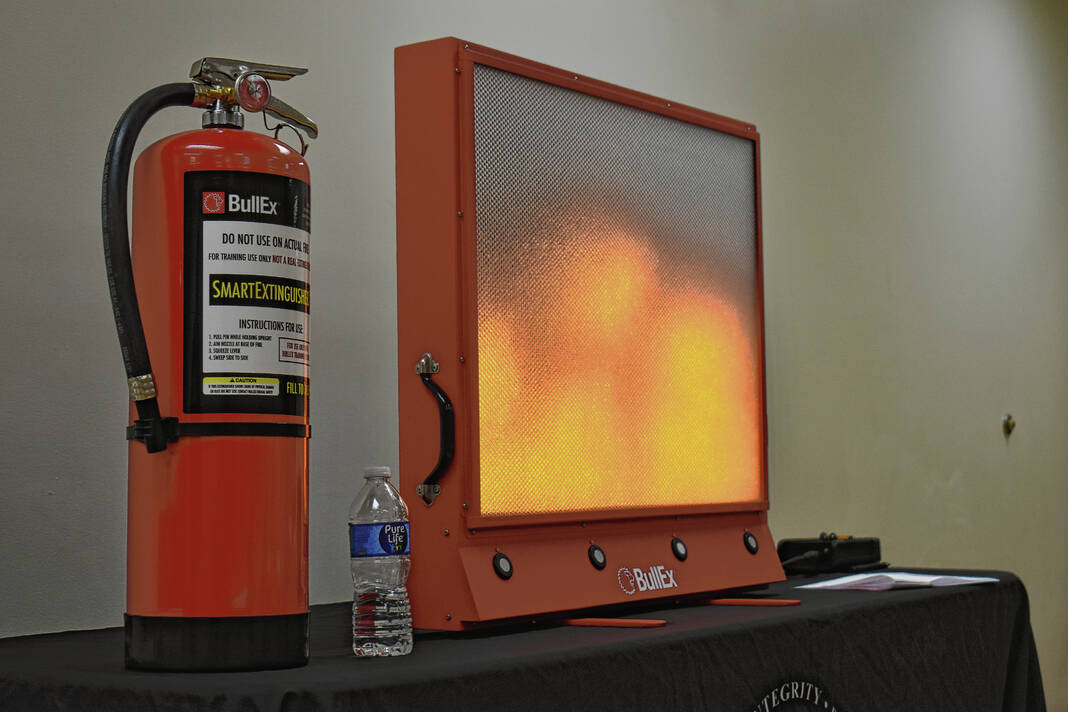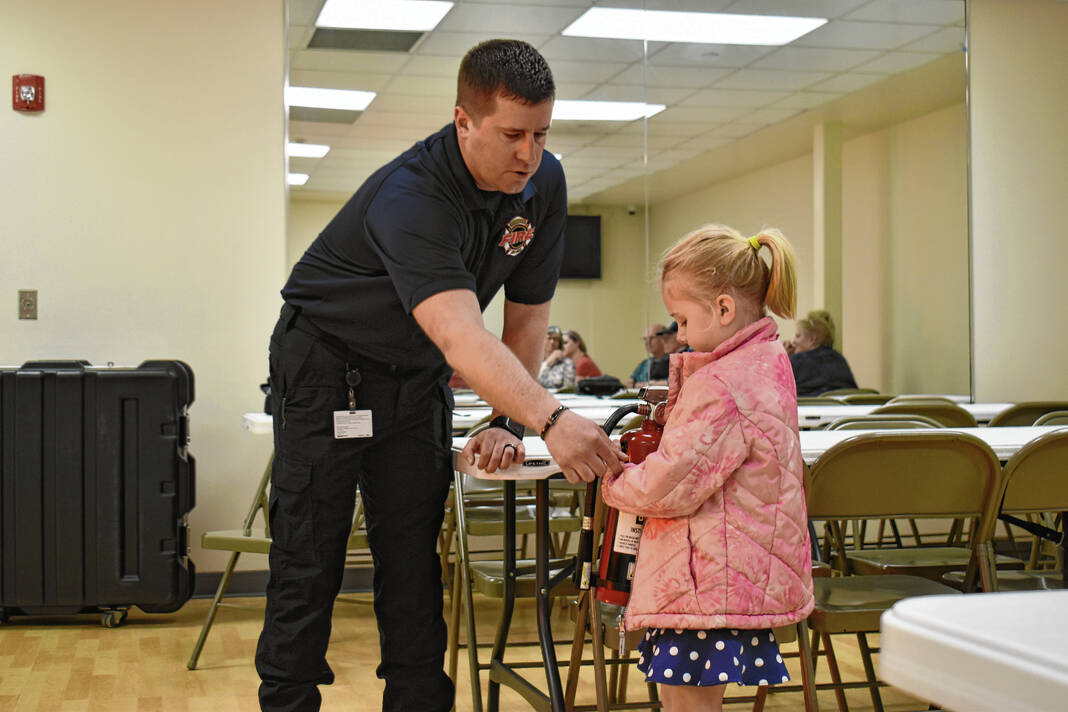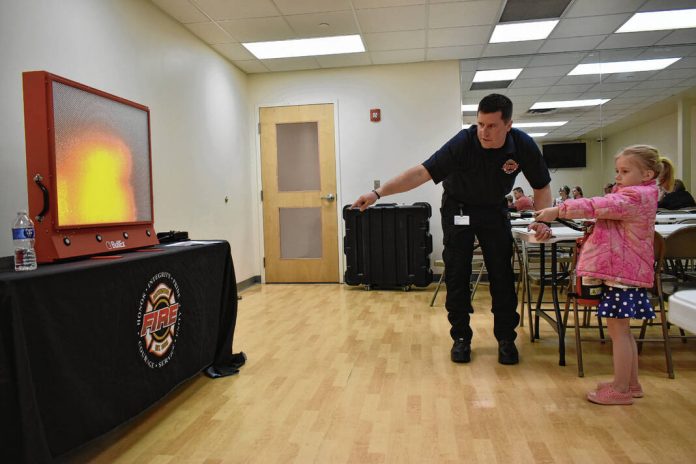
6-year-old Blakely Powell, far right, tries to extinguish a simulated fire as Deputy Fire Marshal Ryan Angrick shows her where to angle the extinguisher Thursday at the Greenwood Community Center. Noah Crenshaw | Daily Journal
The scenario could happen to anyone.
A pot filled with food is cooking on the stove when it catches fire at a home. The cook quickly grabs a nearby fire extinguisher to put it out but freezes as they realize they’ve never used an extinguisher and don’t know how to begin.
Cooking fires are just one scenario where this could happen. Fires could happen at a workplace or in a car too.
The Greenwood Fire Department held one such fire extinguisher training Thursday at the Greenwood Community Center. The trainings, which are free and open to the public, give fire officials the chance to teach residents fire safety, how to use an extinguisher and answer common questions. Residents also have the chance to win a free fire extinguisher to have at home — just in case.
Thursday’s training, the first of the year, was attended by about a dozen or so residents. People as young as four also got a chance to try out their fire extinguishing skills through a simulation, pointing an electronic fire extinguisher at a board to put out the fire.
Different types
There are five different classes of fire extinguishers: A, B, C, D and K. The most common type of extinguisher people will see is a combination of Classes A, B and C, said Ryan Angrick, deputy fire marshal.
Class A fires typically involve combustibles, cardboard, paper or similar materials. Class B fires involve flammable gases or liquids, like gasoline or kerosene, while Class C fires involve energized electrical components, Angrick said.
“These ABC-type [extinguishers] will extinguish all three of those types,” he said.
Class D fires involve metal, and people who work in fabrication, warehousing or welding are more likely to deal with these types of fires. Class K fires are more likely in restaurants, as they typically involve deep fryers, cooking oils or fats, Angrick said.
ABC-type extinguishers tend to be red, while K-type extinguishers are silver, he said.
When to use
Fire officials say there are certain times when people should use fire extinguishers.
The first is when you feel the fire is not overwhelming and is contained, Angrick said. If it starts spreading, it is time to call the fire department, he said.
If the extinguisher is readily available and nearby, people should use it. However, if the extinguisher cannot be easily located, people should not spend time looking for it and should instead evacuate and call 911, Angrick said.
Other times to use an extinguisher include if you know how to use the equipment properly and confidently. If personal safety isn’t compromised, and there is a clear path to an exit, using an extinguisher is a good idea then too, he said.
“If we’re trapped somewhere deep in this building and we don’t know where we’re going, let’s not go searching for an extinguisher and delay our time to egress,” Angrick said. “Evacuate that building, that should be your first priority.”
When it comes to using fire extinguishers, there is a four-letter acronym to remember — PASS. This stands for pull, aim, squeeze and sweep.
The first step is to pull the pin from the top of the fire extinguisher, which is in place to prevent the handle from accidentally being pressed. You then need to stand a safe distance away from the fire, about six to eight feet or so, and aim the nozzle at the base of the fire, according to the Greenwood Fire Department.
After this, you should squeeze the handle to release the extinguishing agent from anywhere for 30 to 45 seconds. Letting go of the handle will stop the extinguishing agent from being released, according to the department.
The final step is to sweep the nozzle of the extinguisher from side to side, spraying at the base of the fire.
“When I say sweep, I don’t mean fan it around. That’s going to add what? Fuel to the fire, add air to that fire,” Angrick said. “We eliminate that oxygen with this extinguisher, that’s what extinguishes that fire.”
Other tips
For stovetop grease fires at home, a K-type extinguisher is best. In lieu of that, people can put baking soda and a lid on top of the pot that is on fire to deprive the flames of air, Angrick said.
Grease fires are hard to get under control once they get past a certain point, he said. If flames can’t easily be extinguished, people should call 911, he said.
If the fire is inside the oven, it should stay closed, be shut off and electricity to it should be turned off at the breaker box, he said.
The same applies to the gas shut off valve for gas stoves. People should also be sure to mention it is a gas stove when reporting the fire to 911, Angrick said.
Most extinguishers last 10 years and people should make sure theirs is not expires. When they do expire, people should spray it out and throw it away, he said.
IF YOU GO
Fire Extinguisher Training Classes
Where: Greenwood Community Center, 100 Surina Way
When: 5:30 to 6:30 p.m. June 27, Sept. 26 and Dec. 19
More information: shorturl.at/tDEP0



